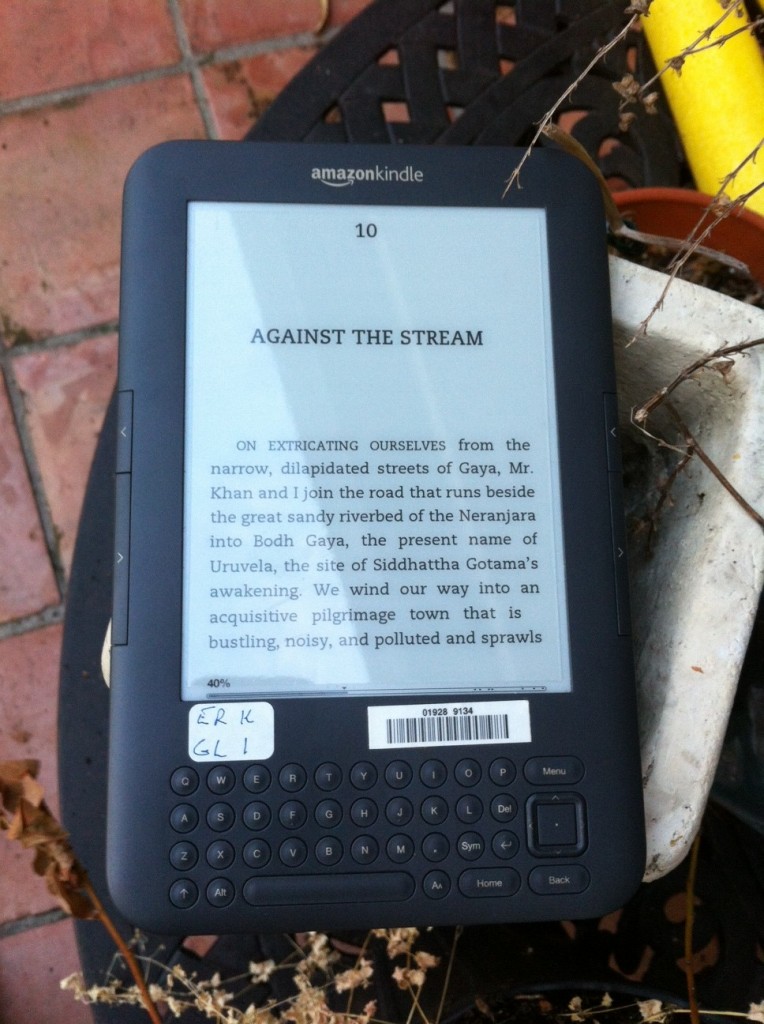Despite the popularity of an e-book reader, I was never really tempted to purchase a Nook or a Kindle. I figured since I have an iPad, it would be completely pointless to own and use a e-book reader, which I understood mostly as a single-purpose device. (But to confess, I didn’t use my iPad much for reading… )
This conviction, however, was completely swept away since I had taken out a library Kindle a few days ago. I never thought that someone like me, who is a firm believer in the superiority of a multi-purpose device (like a smartphone) to a single-purpose device, would become a fan of a single-purpose e-reader.
The university library (which is separate from the library where I work which belongs to the same university but to its medical school) has recently started lending Kindle devices loaded with a number of e-books. As soon as I heard the news, I ran down to the circulation desk to check it out for curiosity. Sure, I had seen an e-book reader before. But there is a world of difference between just looking at a device and tinkering with it for a few minutes and actually using it for oneself for days and weeks. So, I was eager to test it out myself.
I decided to read the e-book, The Immortal Life of Henrietta Lacks, which I have been meaning to read for a while but never found time to. To my surprise, I found myself enjoying the library e-reader way more than I expected.
I loved the much lighter weight and the much less eye-straining screen of a Kindle (compared to my first-generation iPad). But what I loved most about this e-reader was actually its limitation. The fact that I can do nothing but reading.
The greatest problem I had with an iPad ‘as an e-reader’ was that aside from its weight and the eye-straining screen, I could not really concentrate on reading for a long time. I don’t know if this is a non-issue for others with stronger willpower. But for me, this was certainly a big problem. While reading, I would get easily distracted into web surfing, checking e-mails, and reading tweets and Facebook updates. On the other hand, on this single-purpose device, it was easy to continue reading for a much longer time. Sometimes, I would have an urge to go online and do something else. But often I would just ignore the urge as I simply didn’t feel like moving.
Of course, I am not sure if this virtue of a single-purpose device would apply beyond reading, and for that matter, beyond leisure reading. If I were reading for research, I would prefer more robust annotation options as well as easy importing and exporting of documents, which would be much easier on a multi-purpose device. I may well also prefer to be able to easily surf the Internet to search and download whatever document I find useful and start reading it right then and there.
Nevertheless, I found it interesting to think about the merit of a single-purpose device in the times in which multi-purpose devices are more and more prevalent. Maybe we will always have a multi-purpose device and a single-purpose device no matter how advanced technology becomes just like a Swiss Army Knife and a normal knife. Or would more and more devices converge into a few?
*** An additional bonus of a library Kindle is that it comes with more than one book. The borrowing period for this Kindle is two weeks, but I am done with the book already. So after browsing +90 library books that I did not know about, I decided on reading another book. As a librarian, I like the fact that a library e-reader preloaded with multiple library books offer an opportunity for a user to discover more than the one title s/he selected. But also as a librarian, I disliked the fact that the copies of +90 e-books are sitting idly in the device while a user is only using one title. Would there be a possible compromise between these two options?Â


I’m happy to see that you’ve been bitten by the single-purpose e-reader bug. Single-purpose tools are beautiful things: chef’s knives, tuning forks, manual lathes.
I am curious to know if the concept of having single kindles available for checkout, loaded with multiple books, can be a solution to the suggested practice in e-book licensing to limit library lending to N loans for X dollars, since you would be lending the kindle, not the electronic version.
I can envision a future, though, in which professors have two dozen library kindles shelved above their desks, perpetually checked out, and essentially rendered unavailable to mere students for brose or read!
Thanks for the comment! I don’t think loaning the device itself is not a solution to the license limit that ebook publishers impose on library lending. I think if you purchase a Kindle ebook, for example, it can be on 6 devices and not more. So after than new license needs to be purchased. But book publishers may bring out a different model. It is an interesting topic to watch out for future development.
As a library patron, I love that I can borrow a device loaded with ebooks since I don’t need to wrangle with my own personal device to download the library e-book. On the other hand, as a librarian I have some concerns, one of which is having +90 books locked up in one device that can be checked out to one person only at a time.